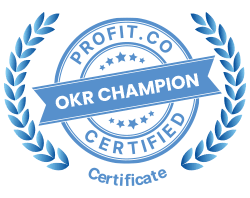🎧⠀Listen and follow
Introduction
CEOs who model OKRs can drive implementation.
We often hear staff say OKRs feel like just another top-down directive. Objectives seem impractical, key results go unmet, and some even game the system or dismiss the process entirely. Why does this happen?
In many cases, the CEO isn’t fully behind the OKR effort. If they aren’t establishing, attending to, and achieving their own OKRs, the initiative is pretty much a token management exercise, not an endeavor to make a difference in culture
👉 New to OKRs? see “What is OKR?”
Leading by example sets the tone.
CEOs who model OKRs have the platform to drive meaningful change. To implement OKRs successfully, they must set and publish measurable objectives of their own. This sets the tone, builds transparency, and fosters alignment.
Larry Page, former CEO of Google and Alphabet, wrote his own OKRs quarterly, proof that OKRs work when leadership walks the talk.
As Ben LaMorte writes in The OKRs Field Book:
“An OKRs program will have almost no chance of success without executive support.”
The CEO’s OKR Wins are contagious
Participation isn’t enough. CEOs must demonstrate results. When leadership achieves OKR goals, it legitimizes the framework and inspires adoption.
“If CEOs can’t complete their own OKRs, why should anyone else.”
This applies across the leadership spectrum. C-suite executives, GMs, and directors must also set transparent, committed OKRs. Yet in my experience, top leadership often treats OKRs as a tool for lower level managers. But strategic goal-setting and being accountable for them are exactly what senior leaders are there for.
CEO Mission and Vision statements anchor OKRs
Before OKRs can drive results, the organization must know where it’s headed. That clarity begins with the CEO. Mission and vision statements act as directional beacons, shaping priorities and giving OKRs context.
In essence, the mission and vision are the organization’s top-level OKRs—and alignment flows from them to every single OKR in the organization.
👉 Learn more – “OKR and the Mission Statement”
If CEOs have time for OKRs, there’s no excuses.
CEOs are pulled in every direction; fires to put out, global travel, board meetings, endless calls. So how can they possibly lead OKRs, let alone manage their own.
That’s exactly why OKRs matter. They help CEOs organize, prioritize, delegate and save time. Once embedded, OKRs run like a well oiled machine. Leadership’s role becomes tracking progress and managing exceptions, not micromanaging details or drowning in meetings.
And if CEOs, in their busy schedule, can block time for OKRs, everyone should be able to – there’s no excuses.
Conclusion: CEOs who model OKRs see best results.
OKRs reflect leadership culture. CEOs who model OKRs are walking the talk, giving OKRs the best chance to become a shared language of clarity and execution.
If CEOs wants to successfully implement change management, they have to demonstrate how OKRs work and show what it takes to succeed in reaching those goals.
If staff disengage from OKRs, it’s not a failure of the framework, it’s a failure of leading the charge. When CEOs, roll up their sleeves and show how it’s done, that’s what real leadership is.

OKR Training Classes in Taiwan
C2believe provides OKR training with classtime, exercises, and coaching.
On Site or Off Site | English or Chinese | In Taiwan (or remote)
- Introduction to OKR for leadership (2 hours)
- Team OKR Class (18 hours) – Classtime, exercises and coaching
- 8-month OKR deployment (coaching and train the trainers)
Contact us about your OKR training needs here









0 Comments